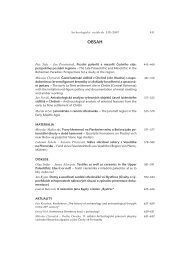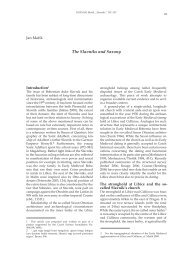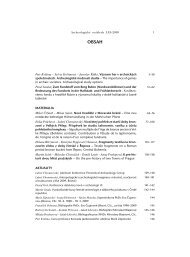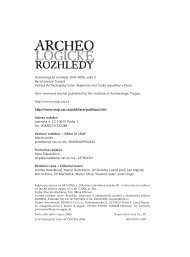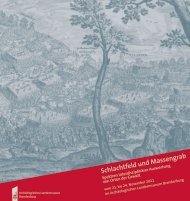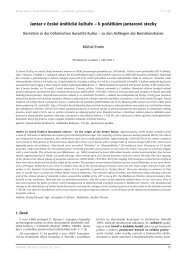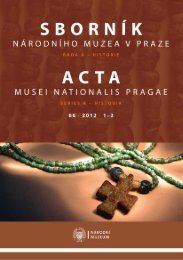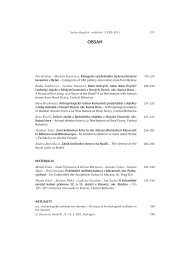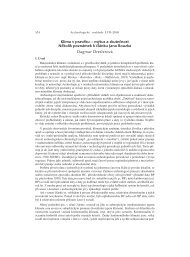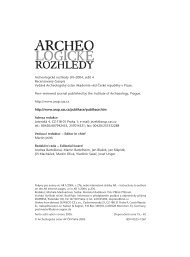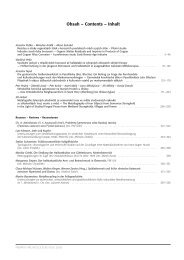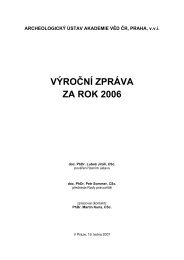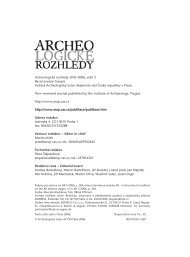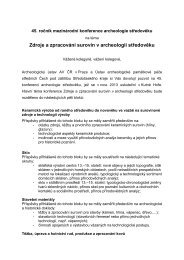You also want an ePaper? Increase the reach of your titles
YUMPU automatically turns print PDFs into web optimized ePapers that Google loves.
Archeologické rozhledy LX–<strong>2008</strong> 227piled. Excavation of unthreatened sites in the historical centre of Prague for the purpose of obtaininginformation is not conducted. Not only has construction activity not decreased in recent years, largerexcavation projects after 2000 have significantly increased in number. Up until now, the largestexcavations have been at Josefská St. No. 42, where 510 m 3 of terrain from the 9 th to 15 th centurywas studied, 3274 m 3 during the construction of a hotel at Karmelitská St. No. 387 and 459 in2003–2004, 3875 m 3 during the construction of the Senate parking garage in 2003–2005, and5655 m 3 during the construction of a hotel at Letenská St. No. 29–33 in 2006–2007.Early Medieval archaeological sites in Prague are dated using a combination of stratigraphy andchronologically-sensitive elements on ceramic finds. Written sources for Early Medieval sites in thearea below the castle are virtually non-existent and appear only on an exceptional basis from the 1140sin connection with extraordinary building projects such as Judith Bridge and the Johannite commendam.The chronology of Early Medieval ceramics is continually refined, representing finer specificationand more distinct movement along the time axis. The result of this progressive recognition is the factthat the dates of many finds in the historical centre of Prague will have to be reassessed and historicalconclusions adjusted to reflect the new dates.The Early Medieval settlement area in Malá Strana formed a fortified section of the “City ofPrague”, settlements outside of the fortifications and burial places (for which there was only partialinformation) outside of the fortified area. However, we do not know the northern course of the fortificationsand therefore not even the size of the fortified area in individual phases and its relationshipto Prague Castle. In fact, it is probably no longer possible to learn the size of this area. In the westernpart of the fortifications, we have been working up until now with several possible courses. The woodand earth walls with stone facing were built in multiple phases. The second phase of the fortificationsalong the southern side of the central section built around the year 900 (fig. 14: 1–7) is the easiestto identify.Residential buildings discovered in Malá Strana include for 9 th –10 th centuries a semi-sunken houseand several small log structures from the 10 th century with wood plank floors and a hearth. These wereaccompanied also by farm-type buildings such as a granary that was later rebuilt as a cellar insidea room with a hearth (a kitchen?) discovered at No. 626 (fig. 14: 46) and pits that perhaps held wickersecured to the walls by small pegs. The pits were discovered at No. 2 (fig. 14: 50). Recessed interiorsfrom the mid-11 th century onwards have been discovered on an exceptional basis. These were possiblythe cellars of above-ground houses (fig. 14: 29).With regard to production activity, it has been shown that iron was made and worked from theEarly „Hillfort“ period (7 th –8 th centuries) to the late 10 th century in the western part of Malostranskénáměstí (Lesser Town Square). Locations where iron ore was potentially mined have also been founddirectly in Malá Strana. Pyrotechnological structures with fired walls from the 11 th and 12 th centurieshave been found at various sites in Malá Strana, with the greatest concentration near NebovidskáSt. Iron working in a later period – the 2 nd half of the 13 th century – has been demonstrated in theproduction district at the base of Petřín Hill and directly at the bridge across the Vltava River inSaská St. (fig. 7). Glass production is assumed to have taken place in the area below the castle onthe basis of finds of ingots with a specific composition and bowls with a glassy coating on their sides(Zavřel 2003). It appears that also non-ferrous metallurgy was practiced in the 12 th century. Scatteredfinds of spindles and a rare find of a distaff at No. 17 document textile decoration (fig. 17). Due to theambiguity in the course of individual phases of the fortifications, the relationship between metallurgicalproduction activity in the 10 th century and the fortified area is not unequivocally known. Accordingto existing clues, this activity is ruled out for the oldest period. However, in the 11 th and 12 th centuriespyrotechnological processes were conducted in the area enclosed by walls in the 10 th century.Only partial information exists on the road network of the town in the 9–10 th centuries. We probablydiscovered part of the gate mechanism in the cellar of the palace at No. 259 (fig. 15: 4). It waspossible to arrive from the east on a bridge documented in the Kristian Legend for the 1 st half of10 th century. In all likelihood, this bridge stood near a later stone bridge from the 12 th century. Neartoday’s Mánes Bridge to the north, where the river with a flood plain and silt-clogged branch was the



